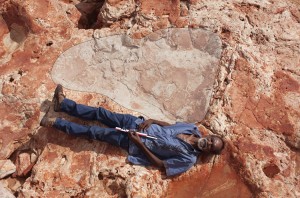Australia’s Ancient Tracks
April 13, 2017
For thousands of years, indigenous (native) people of Western Australia knew about giant ancient footprints along the shore of the Indian Ocean. But only recently have scientists learned about, and been able to study, the tracks, which were made by dinosaurs some 100 million years ago. A team of scientists led by Steven W. Salisbury of the University of Queensland studied the collection of fossilized footprints—which includes the largest ever discovered—for five years. Salisbury and his team recently published their findings as a memoir in the Journal of Vertebrate Paleontology.

Richard Hunter, an elder of the Goolarabooloo community, lies alongside a massive sauropod track in the Walmadany area of Dampier Peninsula in Western Australia. Credit: © Steve Salisbury, University of Queensland
A fossil is the mark or remains of an organism that lived thousands or millions of years ago. Most people think of bones or shells when they hear the word fossil. But tracks, trails, and burrows left by ancient organisms are also extremely important in paleontology (the study of prehistoric life). These marks, called trace fossils, give paleontologists a rare glimpse into the lives of prehistoric animals. The scientists can use trace fossils to answer many questions about an animal’s behavior, such as how it moved or how many animals moved together at a time. Scientists cannot usually pair a trace fossil to an exact species (kind) of animal, but they can often determine broadly what type of animal left the mark.
The fossilized tracks in question are on the northern shores of Western Australia. About 130 million years ago, the region was a sandy floodplain covered with braided rivers. Braided rivers have numerous channels separated by small temporary islands. After the tracks were made, floods rapidly covered them in sediment, preserving them from destruction. Thousands of tracks are scattered over several dozen sites in the area, and about 150 are in excellent condition. The findings give scientists a valuable snapshot into life during the early Cretaceous Period in Australia.
Salisbury and his team identified several types of prints coming from ornithopods (plant-eating dinosaurs that could walk on two or four legs), sauropods (large plant-eating dinosaurs with long necks and tails), stegosaurs (relatives of Stegasaurus), and theropods (meat-eating dinosaurs) of different sizes. One of the tracks measures a whopping 5 ½ feet (1.7 meters) long. This print was made by the hind foot of a huge sauropod some 18 feet (5.5 meters) tall at the hip.
The indigenous people of the Western Australia coast had known of the tracks for thousands of years and had incorporated them into their belief system. In one story, the Dreamtime figure Marala, also known as the Emu Man, makes the three-toed footprints that today are believed to have been made by theropods. (The emu is an Australian bird that has three toes on each foot.) The Dreamtime is a fundamental spiritual concept that connects traditional beliefs and practices among the Aboriginal people of Australia.
In 2008, the state government of Western Australia—unaware of the ancient tracks—proposed that a natural gas processing facility be located near the site. Fearing that the tracks would be damaged or destroyed, the Aboriginal people contacted Salisbury to assess the tracks’ scientific importance. As word spread of the natural gas plant and the damage it could cause to the tracks, environmental groups, paleontologists, and local citizens campaigned for the area to be preserved. The company planning to build the processing plant eventually withdrew its application. Now the tracks, with their important connections to prehistory and the Dreamtime will remain protected.


